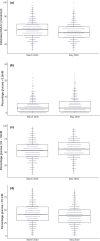Assessment of the effect of the COVID-19 lockdown on glycaemic control in people with type 1 diabetes using flash glucose monitoring
- PMID: 32740984
- PMCID: PMC7436620
- DOI: 10.1111/dme.14374
Assessment of the effect of the COVID-19 lockdown on glycaemic control in people with type 1 diabetes using flash glucose monitoring
Abstract
Aim: To describe the effect of the stringent lockdown measures, introduced in the UK on 23 March 2020 to curtail the transmission of COVID-19, on glycaemic control in people with type 1 diabetes using flash glucose monitoring.
Methods: We undertook an observational study of 572 individuals with type 1 diabetes for whom paired flash glucose monitoring data were available between early March and May 2020. The primary outcome was change in flash glucose monitoring variables. We also assessed clinical variables associated with change in glycaemic control.
Results: Percentage of time in range increased between March and May 2020 [median (interquartile range) 53 (41-64)% vs 56 (45-68)%; P < 0.001], with associated improvements in standard deviation of glucose (P <0.001) and estimated HbA1c (P <0.001). There was a small reduction in the number of individuals meeting the hypoglycaemia target of <5% per day (64% vs 58%; P = 0.004). Comparing changes in flash glucose monitoring data from March to May in 2019 with the same period in 2020 confirmed that these differences were confined to 2020. Socio-economic deprivation was an independent predictor of a ≥5% reduction in time in range during lockdown (odds ratio 0.45 for people in the two most affluent Scottish Index of Multiple Deprivation quintiles; P <0.001).
Conclusions: Lockdown was not associated with a significant deterioration in glycaemic control in people with type 1 diabetes using flash glucose monitoring. However, socio-economic deprivation appeared to increase the risk of decline in glycaemic control, which has implications for how support is focused in challenging times.
© 2020 The Authors. Diabetic Medicine published by John Wiley & Sons Ltd on behalf of Diabetes UK.
Figures
References
-
- [Withdrawn] Guidance on social distancing for everyone in the UK [Internet]. GOV.UK. [cited 2020 May 17]. Available at https://www.gov.uk/government/publications/covid‐19‐guidance‐on‐social‐d...
Publication types
MeSH terms
Substances
LinkOut - more resources
Full Text Sources
Medical
Miscellaneous


